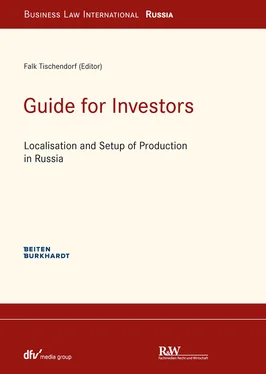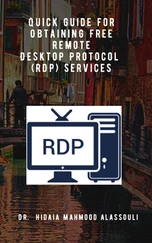Notwithstanding the aforementioned difficulties, positive trends can clearly be observed in Russia. After the past three years we have realised how insignificant investments have been in the industry that remained after the Soviet Union and how dramatically the development gap has widened compared to Western and Asian countries. It goes without saying that the current strained relations between Russia and many countries have stimulated a new understanding of industrial development priorities, and that Russia is now trying to reduce this gap. Cooperation in the area of localisation and maintaining a presence in a country with such huge resources represent a serious framework for closing the current gap. Russia and Germany have in their histories experienced hard times. However, dialogue between the two countries has never stopped. The presence of German R&D in Russia can only benefit mutual understanding between our countries.
Location of manufacturing – Organisation of production – Localisation, Experience of the manager of a corporate group
Dr. Gerd Lenga, CEO of KNAUF CIS Group in 2006–2014
Sooner or later, anyone who supplies goods to Russia asks themselves this question: do you want to continue engaging in trade only, or do you need to manufacture goods on this market? The decision depends on a number of conditions, the significance of which varies in practice. The reader may find some kind of advice in the following that will supplement their own thoughts on the matter.
Any production initiative goes through the typical project stages to establish a manufacturing facility, and begins with general considerations on the investment decision. This is followed by the planning stage, after which you have to ensure the necessary infrastructure is available. Then the construction itself begins. When it is completed, the questions arise of procuring machines and equipment for production, as well as finding personnel. Only after all of this can business activity really begin. This stage, i.e. the actual manufacturing activity itself, always lies in the realm of risk management, since it is essential to take into account the specifics of doing business in Russia and the particularities of working with your own (generally Russian) employees.
1. Any decision to invest in the Russian economy, i.e. to economically engage in capital investments, is both economic and political in nature: business people make their own decisions on expanding business abroad. Or, perhaps, the business has sufficient existing capacity and will continue to try to deliver a certain part of its products to Russia.
To limit yourself to trade alone is an understandable position to take, and one that does not require any particular entrepreneurial ambitions and keeps all expenses in view: the terms of import and export, receipt of possible certificates and permits, distribution channels and logistics, and finally issues of customs and currency legislation – all of them are part of the fairly long but still finite list of questions that have to be addressed. With ongoing operations, they need only to be updated from time to time.
If business doesn’t go as expected, there are no serious costs involved in leaving the market. Thus, on the one hand the risk is limited. However, you have also excluded the possibility of expanding the business, with increased turnover and profits, and sooner or later under the decisive heat of competition you will have to cede an attractive market with more than one hundred forty million consumers, and also – don’t forget! – lose a chance to enhance your business reputation.
Experience shows that with growing success on the market, the chances that appear are rated higher than risks. Based on this, the readiness for investment grows. Here the question should be raised of whether the entrepreneur has sufficient funds to finance the expansion of business abroad. If the desire to invest is stronger than the doubts, the entrepreneur’s chances of doing business on the new market may still be clouded by the financial risks involved: anticipated profits take second place; in first place is the question of the financial capability of the businessman faced with an investment decision.
Anyone who suddenly exceeds the bounds of their investment budget, regardless of the reasons, in the absence of sufficient funds to do so may lose out, sometimes losing everything, as many medium-sized enterprises did in the 1990s. Back then, real costs on organising a production facility were substantially underestimated, and this still applies today: Russia is an expensive country for investors, since setting up a production facility involves more than simply building the facilities. In the majority of cases, the necessary infrastructure must at a minimum be adapted to meet the needs of the facility, if not built outright from scratch.
2. In addition to financial risks, the investor must also attempt to assess the effect of the political situation. The question must be asked: is the current political situation in Russia stable and will the Russian sales market remain attractive for the foreseeable future?
At present, a relatively stable political situation prevails in Russia, which is not an obstacle to investment.
3. However, political stability alone does not justify investment – investors pay more attention to economic development. According to all forecasts, not just those of the Russian Ministry of Economic Development but also those of the International Monetary Fund, the World Bank, and European banks operating in Russia, despite all efforts to stop the development of the Russian economy through sanctions, it has begun, albeit slowly, to grow again: in comparison with our economy the rate of growth is low; however, for gross domestic product it is forecast at 2 % for the next few years, while inflation is expected to be at the unbelievable level of 3 % or even less.
Several sectors, such as agriculture or pharmaceuticals (unfortunately not yet the automobile industry) are already again showing positive trends. Even American investment banks recommend investing right now, and are themselves investing: after the recent difficult years, it is now profitable to acquire a company, all the more so since the contractions and restructuring needed in connection with the crisis have frequently already been completed. Local recruitment consultants recommend stopping staffing reductions gradually, in order to avoid a situation in two years’ time where you again have to compete with other companies for qualified employees.
4. Having established that neither the political nor economic conditions are an obstacle to setting up a manufacturing facility in Russia, the next question to come up is that of the legal framework, specifically: is the legal system that has taken shape over the last quarter century sufficiently stable, or can you expect substantial measures limiting investors’ rights? According to statements, including those recently made by senior officials to the captains of German industry, no restrictions whatsoever are planned, and there have never been any such changes over the period in question. The Russian state is interested as never before in attracting investors and establishing manufacturing enterprises, together with technology transfers in many sectors. The government is even offering financial incentives in this regard: the “special investment contracts” that have been advertised widely and concluded in large numbers in recent years offer various incentives, from tax concessions to subsidies. Limiting the rights of entrepreneurs would not only run counter to this economic policy, but would scare off investors and, of course, the politicians responsible for economic policy know that.
The conditions for doing business in Russia have actually improved according to investors talking about the business climate, as reflected in the review “Doing Business in Russia”, for example. Russia took 120th place out of 190 countries in this ranking in 2011, but since then, despite all the sanctions, it has gradually risen to 31st place by 2019. Although the goal of 20th place set by President Putin has not yet been achieved, Russia is ahead of France and Italy and one place behind Spain.
Читать дальше












